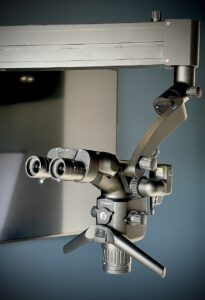Microscopic root canal treatment
The sub-area of root canal treatment is also called endodontics and can be found in every practice for modern dentistry. It involves healing inflammations inside the teeth as well as the periodontium - with the aim of preserving the patient's own tooth. Particularly great success can be achieved with microscopic root canal treatment.
What is root canal treatment?
Root canal treatment is a procedure in which the inside of a tooth is removed. Then the dentist puts sterile material to close it. In this way, even the teeth that are no longer healthy can be preserved. Reasons for root canal treatment can be inflammation of the tooth root or pulp. In some cases, teeth are also completely dead.
Root canal treatment is only performed when the inside of the tooth - also called the pulp - can no longer be saved. Using a special procedure, the treating doctor hollows out the tooth and fills it up again. This filling prevents bacteria from entering and further damaging the tooth.
Inflammation inside the tooth occurs, for example, when caries penetrates deeply or a piece of tooth breaks away. In this way, bacteria gain access and can multiply. If such an inflammation remains untreated, it can even spread to the jawbone, weaken the immune system and cause other complaints.
Microscopic root canal treatment - when necessary?
When is the best time to perform root canal treatment? The most common reason is pain and inflammation of a tooth. In the course of inflammation, the blood vessels located inside the tooth dilate and press on the tooth nerve. This causes severe pain. Affected persons react sensitively to cold or hot drinks and food.
From this point on, an appointment for treatment should already be made. This is because if the bacteria continue to spread, they can be distributed throughout the body via the blood. Thus, inflammation occurs in the entire organism, which must be prevented with the help of microscopic root canal treatment.
What is the procedure for root canal treatment under the microscope?
A root canal treatment goes through several steps. First, the teeth must be prepared accordingly, and then it's time for the filling.
Hollowing out a tooth in the course of root canal treatment can be very painful. For this reason, it is carefully anesthetized in advance. The dentist isolates the tooth to be treated with a latex rubber. In this way, no new bacteria can penetrate. To achieve particularly good results, the root canals are rinsed with disinfecting solutions during treatment.
To ensure that no residual diseased tissue remains in the tooth, the root canals must be precisely cleaned. The dentist carefully removes all germs and tissue remnants from inside these fine canals. This is where the microscope comes in: with its help, even the smallest root canal can be traced and cleaned.
A precise procedure is important for the long-term preservation of the tooth. Root canal treatment is only successful if it can be ruled out that germs can no longer multiply inside the tooth.
Only when the tooth is completely germ-free does the dentist fill the canal system with a special root filling. Since this weakens the tooth somewhat, it is stabilized with a crown.

How often does root canal treatment have to be performed?
In some cases, a root canal treatment is followed by a new procedure. This is called a revision when germs and bacteria have again multiplied inside the tooth. Such a case can only occur if the root canals were not thoroughly cleaned in preparation or the tooth was not carefully filled and sealed. Often the root canals are so ramified that it is difficult for the dentist to reach them all.
The doctor can find out the cause of a new inflammation with the help of an X-ray. It is often a case of incomplete root fillings. They do not reach the end of the tooth roots or have irregularities. These include cavities and blisters.
Then the tooth can only be preserved by revision. Therefore, it is important to be precise already during the first root canal treatment. While the success rate for a normal treatment is around 35%, a microscopic root canal treatment can achieve as much as 95%. The risk of a revision is therefore significantly lower.
Advantages of microscopic root canal treatment
Teeth and roots have numerous canal entrances. A microscope is necessary to find all of them. This is the only way to find all canal entrances and treat roots effectively. This approach has increased the success rate.
The microscope is already used as a practical aid during the preparation of the teeth. With it, the treating physician can check whether really all remnants of the tissue or a root filling have been removed. This allows the rest of the treatment to be carried out effectively.
The goal of preserving the patient's own tooth is fulfilled by this type of root canal treatment. After treatment, it even looks like all other teeth, which is a great optical advantage.
By the way, every tooth counts. If teeth are extracted, the jawbone shrinks in the corresponding places. In addition, real teeth still feel the most natural, so it is also in the patient's interest to have root canal treatment performed.
The microscope also constantly monitors the process of closing the root canals. This is the key to results that not only look good, but also last a long time. Normal root canal treatment cannot be performed with such precision.

Special features of microscopic root canal treatment with us in Munich
Anyone undergoing root canal treatment should be aware of the possible risks. Pain and swelling are common side effects of both normal and microscopic root canal treatment.
What can be largely prevented by using a microscope, however, are injuries to nerves, muscles and bones. This is due to the precise working method. In addition, microscopic root canal treatment causes far less damage to surrounding teeth.
So what makes microscopic root canal treatment so special is the high level of precision and the high success rate. Thanks to the support provided by a microscope, re-inflammation is less frequent, saving patients not only time but also pain.
However, since microscopic root canal treatment involves some special features, it should only be performed by a specialist. The dentists at Asamhof Munich will be happy to assist you. Thanks to our many years of experience, we know exactly what we are doing and what needs to be taken into account.
In addition, we rely on the best equipment for microscopic root canal treatment in Munich. With the help of the Microscope Diagnostic "CALIPSO" MD 500-Dental, the smallest details can be captured. Equipped with an LED with more than 60,000 lux, the root canals are perfectly illuminated. This makes it the ideal tool for effective root canal treatments.



